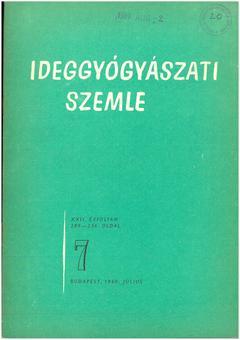The eLitMed.hu medical portal uses computer cookies for convenient operation. Detailed information can be found in the Cookie-policy.
Clinical Neuroscience - 1969;22(07)
Content
[Data on the pathogenesis of gliomas of the corpus callosum]
[An anatomical-localisational analysis of 12 corpus callosum glioma cases, in addition to a review of the leading psychiatric and motor symptoms, was combined with a study of the findings of radiographic contrast studies. In addition to mentioning the value of the findings obtained by the two contrast methods, we emphasize that the two radiological aids can complement each other and that, therefore, in certain cases, we consider it necessary to perform both.]
[Incidence of juvenile metachromatic leukodystrophy familiaris]
[Authors discuss the relatively rare juvenile-type matachromatic leukodystrophy (M.L.) familiaris. In our cases, the first symptom was forced feeding, followed by extrapyramidal symptoms and movement disorders. Total CSF protein was moderately elevated only in our more severe case. The peripheral nerve conduction was characteristically slowed. Chromosomal analysis of fvs cultures showed no abnormalities. Cultured chromosome analysis in both patients showed no abnormality. In both patients, biopsies were taken from the n. cut. surae-lat. and in one case from the frontal lobe of the brain. Histopathology revealed a moderate degree of neuropathy. The diagnosis of M. L. was confirmed in vivo on the basis of a characteristic histological picture showing brown metachromasia with acetic acid cresyl violet. Myelin sheath lesions in M. L. were examined by electron microscopy. Nodular stitching of small fragments of the myelin sheath and phagocytosis into the astrocyte were observed. The intra-sheath oligodendroglial protrusion was generally more massive than usual, presumably indicating increased regeneration. The observations provide data that inclusiform bodies may be derived from the myelin sheath. The authors discuss the difficulties of in vivo diagnosis of M. L. in the Discussion. They discuss the possible link between M. L. and epilepsy and the EEG, EMG and nerve conduction velocity abnormalities observed in their patients. Biochemical aspects of the aetiology of the disease are summarised. Based on the analysis of the siblings' family trees and literature data, it is considered possible that within a family there is a combination of different types of M. L. disorders.]
[The importance of modern serological tests in the diagnosis and therapy of neurological disorders]
[Specific treponema assays were performed in the blood serum of 115 patients, both to provide serological evidence of clinically suspected neurolues without a history of luesian disease and to inform further treatment or management of patients with a known history of previously treated neurolues. Accordingly, the patient population was divided into 3 groups: group I for cases suspected of having neurolues, group II for cases with positive treponema reactions, group III for cases with known neurolues and negative treponema tests. In the assessment of the need for treatment, the positivity of treponema tests was found to be of minor importance compared to the possibilities offered by clinical observations, while the negativity of treponema tests was found to be a minor, not decisive factor in determining the cure. The diagnostic value of treponema tests in clinically probable neurological lesions, especially those manifesting as organic psychosyndromic symptoms, is of even greater importance. ]
1.
Clinical Neuroscience
[Headache registry in Szeged: Experiences regarding to migraine patients]2.
Clinical Neuroscience
[The new target population of stroke awareness campaign: Kindergarten students ]3.
Clinical Neuroscience
Is there any difference in mortality rates of atrial fibrillation detected before or after ischemic stroke?4.
Clinical Neuroscience
Factors influencing the level of stigma in Parkinson’s disease in western Turkey5.
Clinical Neuroscience
[The effects of demographic and clinical factors on the severity of poststroke aphasia]1.
2.
3.
4.
5.



